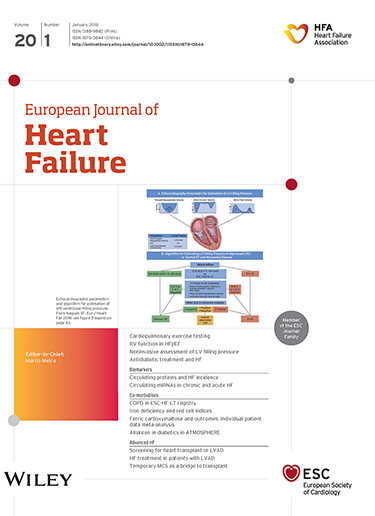心衰结局和恩格列净对窦性心律或房颤心衰和射血分数降低患者的影响:来自EMPEROR-Reduced的数据
IF 10.8
1区 医学
Q1 CARDIAC & CARDIOVASCULAR SYSTEMS
引用次数: 0
摘要
AIMSEmpagliflozin降低心血管死亡(CVD)或心力衰竭住院(HHF),减缓估计肾小球滤过率(eGFR)下降,改善心力衰竭伴射血分数(HFrEF)降低的生活质量(QoL)。依帕列净对房颤(AF)的影响是否一致值得探讨。方法和结果研究了AF与窦性心律(SR)对结果、eGFR下降和生活质量的影响。在可获得心律分析的患者中,在排除了节律缺失或有节奏的患者后,纳入了2785例患者(AF, n = 928, SR, n = 1857)。主要终点(p = 0.66)、首次终点(p = 0.19)和复发性HHF (p = 0.45)的差异无统计学意义。在安慰剂组,房颤和房颤之间的酒精摄入(相互作用p = 0.32)、体重指数(相互作用p = 0.93)、糖尿病(相互作用p = 0.52)、高血压(相互作用p = 0.24)没有差异。低射血分数和高肾病:改善整体结局(KDIGO)类别的事件发生率更高,但SR和房颤之间分别没有相互作用。中位随访20个月后,与安慰剂相比,恩格列净在房颤和SR中降低了CVD或HHF(风险比[HR] 0.82, 95%可信区间[CI] 0.63-1.08;风险比[HR] 0.69, 95% CI 0.56-0.84;相互作用p = 0.29)。同样适用于首次HHF的时间(相互作用p = 0.20),而首次和复发HHF存在临界但不显著的相互作用(p = 0.10)。对eGFR年下降和生活质量评分的影响无显著差异。发生率较低,但形式上没有显著差异(HR 0.66, 95% CI 0.40-1.09, p = 0.11,恩格列净vs安慰剂)。结论:在HFrEF中,AF没有显著改变调整后的结果,也与eGFR斜率无关。恩帕列净降低了结果,eGFR下降,改善了生活质量,无论AF或SR,并可能减少了AF的发生。本文章由计算机程序翻译,如有差异,请以英文原文为准。
Heart failure outcomes and empagliflozin effects in patients with heart failure and reduced ejection fraction in sinus rhythm or atrial fibrillation: Data from EMPEROR-Reduced.
AIMS
Empagliflozin reduces cardiovascular death (CVD) or hospitalization for heart failure (HHF), slows estimated glomerular filtration rate (eGFR) decline and improves quality of life (QoL) in heart failure with reduced ejection fraction (HFrEF). Whether the effect of empagliflozin is consistent according to atrial fibrillation (AF) status is worth exploring.
METHODS AND RESULTS
The impact of AF versus sinus rhythm (SR) on outcomes as well as on eGFR decline and QoL were studied post-hoc in EMPEROR-Reduced. Of patients with available rhythm analyses and after exclusion of patients with missing or paced rhythms, 2785 were included (AF, n = 928, SR, n = 1857). Differences were not significant for the primary endpoint (p = 0.66), first (p = 0.19) and recurrent HHF (p = 0.45). On placebo, alcohol consumption (interaction p = 0.32), body mass index (interaction p = 0.93), diabetes (interaction p = 0.52), hypertension (interaction p = 0.24) were not different between AF and SR. Low ejection fraction and high Kidney Disease: Improving Global Outcomes (KDIGO) class had higher event rates but without interaction between SR and AF, respectively. After a median follow-up of 20 months, empagliflozin reduced CVD or HHF compared to placebo in AF and SR (hazard ratio [HR] 0.82, 95% confidence interval [CI] 0.63-1.08; and HR 0.69, 95% CI 0.56-0.84; interaction p = 0.29). The same applied to time to first HHF (interaction p = 0.20), while there was a borderline but insignificant interaction for first and recurrent HHF (p = 0.10). The effect on annual eGFR decline and QoL scores was not different. Incident AF was numerically lower but formally not significantly different (HR 0.66, 95% CI 0.40-1.09, p = 0.11, empagliflozin vs. placebo).
CONCLUSIONS
In HFrEF, AF did not significantly modify outcomes after adjustment and did not associate with eGFR slopes. Empagliflozin reduced outcomes, eGFR decline and improved QoL regardless of AF or SR and probably reduced incident AF.
求助全文
通过发布文献求助,成功后即可免费获取论文全文。
去求助
来源期刊

European Journal of Heart Failure
医学-心血管系统
CiteScore
27.30
自引率
11.50%
发文量
365
审稿时长
1 months
期刊介绍:
European Journal of Heart Failure is an international journal dedicated to advancing knowledge in the field of heart failure management. The journal publishes reviews and editorials aimed at improving understanding, prevention, investigation, and treatment of heart failure. It covers various disciplines such as molecular and cellular biology, pathology, physiology, electrophysiology, pharmacology, clinical sciences, social sciences, and population sciences. The journal welcomes submissions of manuscripts on basic, clinical, and population sciences, as well as original contributions on nursing, care of the elderly, primary care, health economics, and other related specialist fields. It is published monthly and has a readership that includes cardiologists, emergency room physicians, intensivists, internists, general physicians, cardiac nurses, diabetologists, epidemiologists, basic scientists focusing on cardiovascular research, and those working in rehabilitation. The journal is abstracted and indexed in various databases such as Academic Search, Embase, MEDLINE/PubMed, and Science Citation Index.
 求助内容:
求助内容: 应助结果提醒方式:
应助结果提醒方式:


